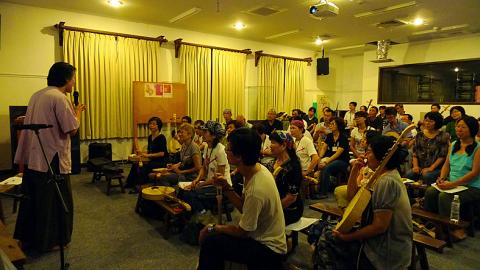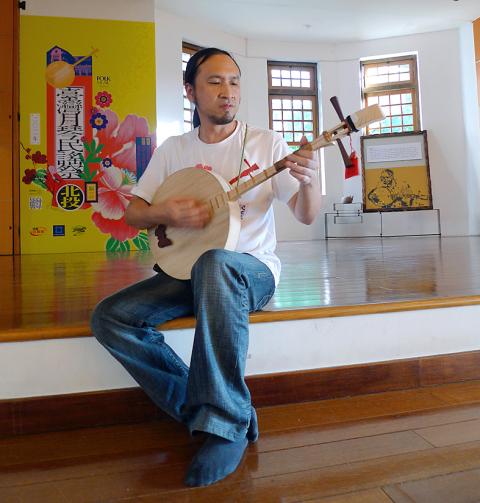Beitou District (北投), famed for its hot springs, is doubling as host to a musical feast this weekend. The Taiwan Moon Lute Folk Music Festival (台灣月琴民謠祭) comprises concerts tomorrow and Sunday at the Beitou Hot Springs Museum by a slew of the country’s top folk musicians.
The new festival began earlier this month with a series of lectures by folk virtuosos, who demonstrated the two-string instrument’s widespread use in Taiwanese music.
Iconic musician Chen Ming-chang (陳明章), who organized the event, said the moon lute, or yueqin (月琴), is a representative instrument of Hoklo music and commonly used in a variety of genres: Gezai opera (歌仔戲); Hengchun folk music (恆春調); nanguan (南管); beiguan (北管); chia-ko (車鼓); and liam kua (唸歌), a Taiwanese performance art form that interweaves talking and singing.

Photo courtesy of Taiwan Moon Lute Folk Music Association
“The yueqin is to Taiwan as the samisen is to Japan, or morin khuur to Mongolia,” Chen said, referring to stringed instruments from those countries. “It represents our culture’s most classical characteristics. I hope one day people will come to Taiwan to see yueqin or liam kua shows, just like we go to see samisen or kabuki shows when visiting Japan.”
Tomorrow evening there will be an open jam session with renowned musicians, including Chen and Lin Sheng-xiang (林生祥), that is open to anybody who wants to show off his or her yueqin skills.
Chen said the instrument generates a distinctive sound that is somewhat similar to that of blues music. Because of its simplicity, the yueqin’s timbre is more fluid and flexible than that of more elaborately designed Chinese instruments.

Photo courtesy of Taiwan Moon Lute Folk Music Association
“After Zheng Chenggong (鄭成功, better known as Koxinga) and his gang came to Taiwan, it was unlikely that they would go back to China just to buy a musical instrument. They were poor and could only use what was available at hand. They put together some wood planks, and now you have this simple tool that can produce amazingly complex music,” said Chen, who has taught yueqin to some 200 students in Beitou over the past two years.
On Sunday, octogenarian folk legends including Chu Ting-chun (朱丁順), under whom Chen has studied yueqin and Hengchun folk tunes, as well as Yang Hsiu-ching (楊秀卿) and Wang Yu-chuan (王玉川), both of whom are highly revered liam kua virtuosos, will perform.
Hailing from Yunlin County, the Wu Tien-lo (吳天羅) family’s Hsuyang Chia-ko Troupe (旭陽車鼓劇團) will show Taipei audiences the art of chia-ko, a type of grassroots operatic theater that combines song, dance, spoken dialogue and drama.
All of the festival performances will take place on the lawn outside the museum’s main building.
Aside from the musical performances, an exhibition of hand-painted moon lutes will run through Oct. 2 inside the museum, which was built in 1913 during the Japanese colonial era and designated as a heritage site in 1997. It is located a short, pleasant walk from Xinbeitou MRT Station (新北投捷運站).

Many people noticed the flood of pro-China propaganda across a number of venues in recent weeks that looks like a coordinated assault on US Taiwan policy. It does look like an effort intended to influence the US before the meeting between US President Donald Trump and Chinese dictator Xi Jinping (習近平) over the weekend. Jennifer Kavanagh’s piece in the New York Times in September appears to be the opening strike of the current campaign. She followed up last week in the Lowy Interpreter, blaming the US for causing the PRC to escalate in the Philippines and Taiwan, saying that as

US President Donald Trump may have hoped for an impromptu talk with his old friend Kim Jong-un during a recent trip to Asia, but analysts say the increasingly emboldened North Korean despot had few good reasons to join the photo-op. Trump sent repeated overtures to Kim during his barnstorming tour of Asia, saying he was “100 percent” open to a meeting and even bucking decades of US policy by conceding that North Korea was “sort of a nuclear power.” But Pyongyang kept mum on the invitation, instead firing off missiles and sending its foreign minister to Russia and Belarus, with whom it

The Chinese Communist Party (CCP) has a dystopian, radical and dangerous conception of itself. Few are aware of this very fundamental difference between how they view power and how the rest of the world does. Even those of us who have lived in China sometimes fall back into the trap of viewing it through the lens of the power relationships common throughout the rest of the world, instead of understanding the CCP as it conceives of itself. Broadly speaking, the concepts of the people, race, culture, civilization, nation, government and religion are separate, though often overlapping and intertwined. A government

Nov. 3 to Nov. 9 In 1925, 18-year-old Huang Chin-chuan (黃金川) penned the following words: “When will the day of women’s equal rights arrive, so that my talents won’t drift away in the eastern stream?” These were the closing lines to her poem “Female Student” (女學生), which expressed her unwillingness to be confined to traditional female roles and her desire to study and explore the world. Born to a wealthy family on Nov. 5, 1907, Huang was able to study in Japan — a rare privilege for women in her time — and even made a name for herself in the